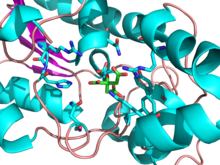
Back فوسفوغليسيرات موتاز Arabic Фосфолицерат мутаза Bulgarian Phosphoglyceratmutase German Fosfoglicerato mutasa Spanish فسفوگلیسرات موتاز Persian Fosfoglyseraattimutaasi Finnish Phosphoglycérate mutase French Fosfoglicerato mutase Galician Fosfoglicerato mutasi Italian 포스포글리세르산 변위효소 Korean

| Phosphoglycerate mutase family | |||||||||||
|---|---|---|---|---|---|---|---|---|---|---|---|
| Identifiers | |||||||||||
| Symbol | PGAM | ||||||||||
| Pfam | PF00300 | ||||||||||
| InterPro | IPR013078 | ||||||||||
| PROSITE | PDOC00158 | ||||||||||
| SCOP2 | 3pgm / SCOPe / SUPFAM | ||||||||||
| |||||||||||
| phosphoglycerate mutase 1 (brain) | |||||||
|---|---|---|---|---|---|---|---|
 | |||||||
| Identifiers | |||||||
| Symbol | PGAM1 | ||||||
| Alt. symbols | PGAMA | ||||||
| NCBI gene | 5223 | ||||||
| HGNC | 8888 | ||||||
| OMIM | 172250 | ||||||
| RefSeq | NM_002629 | ||||||
| UniProt | P18669 | ||||||
| Other data | |||||||
| EC number | 5.4.2.11 | ||||||
| Locus | Chr. 10 q25.3 | ||||||
| |||||||
| phosphoglycerate mutase 2 (muscle) | |||||||
|---|---|---|---|---|---|---|---|
| Identifiers | |||||||
| Symbol | PGAM2 | ||||||
| NCBI gene | 5224 | ||||||
| HGNC | 8889 | ||||||
| OMIM | 261670 | ||||||
| RefSeq | NM_000290 | ||||||
| UniProt | P15259 | ||||||
| Other data | |||||||
| EC number | 5.4.2.11 | ||||||
| Locus | Chr. 7 p13-p12 | ||||||
| |||||||
- This enzyme is not to be confused with Bisphosphoglycerate mutase which catalyzes the conversion of 1,3-bisphosphoglycerate to 2,3-bisphosphoglycerate.
Phosphoglycerate mutase (PGM) is any enzyme that catalyzes step 8 of glycolysis - the internal transfer of a phosphate group from C-3 to C-2 which results in the conversion of 3-phosphoglycerate (3PG) to 2-phosphoglycerate (2PG) through a 2,3-bisphosphoglycerate intermediate. These enzymes are categorized into the two distinct classes of either cofactor-dependent (dPGM) or cofactor-independent (iPGM).[1] The dPGM enzyme (EC 5.4.2.11) is composed of approximately 250 amino acids and is found in all vertebrates as well as in some invertebrates, fungi, and bacteria. The iPGM (EC 5.4.2.12) class is found in all plants and algae as well as in some invertebrate, fungi, and Gram-positive bacteria.[2] This class of PGM enzyme shares the same superfamily as alkaline phosphatase.[3]
- ^ Johnsen, U; Schönheit, P (September 2007). "Characterization of cofactor-dependent and cofactor-independent phosphoglycerate mutases from Archaea". Extremophiles: Life Under Extreme Conditions. 11 (5): 647–57. doi:10.1007/s00792-007-0094-x. PMID 17576516. S2CID 5836321.
- ^ Jedrzejas, MJ (2000). "Structure, function, and evolution of phosphoglycerate mutases: comparison with fructose-2,6-bisphosphatase, acid phosphatase, and alkaline phosphatase". Progress in Biophysics and Molecular Biology. 73 (2–4): 263–87. doi:10.1016/s0079-6107(00)00007-9. PMID 10958932.
- ^ Galperin, MY; Bairoch, A; Koonin, EV (August 1998). "A superfamily of metalloenzymes unifies phosphopentomutase and cofactor-independent phosphoglycerate mutase with alkaline phosphatases and sulfatases". Protein Science. 7 (8): 1829–35. doi:10.1002/pro.5560070819. PMC 2144072. PMID 10082381.
© MMXXIII Rich X Search. We shall prevail. All rights reserved. Rich X Search